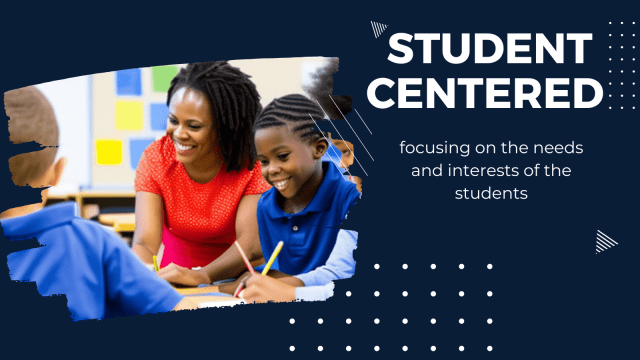My passion is not Google or any kind of technology. It is for student-centered classrooms. It’s hard. It’s easier to come to class every day and share what I know with the class. It is difficult to think about how the students will influence the lesson. So what is involved with the people I am teaching today? How are the students going to talk more than me? How do I encourage my students to be passionate about learning the content without first learning what they are passionate about? I like to tell my student teachers, “This is not a math job, this is a people job.” There are many characteristics of a student-centered classroom, here are a few:

Characteristics of a student-centered classroom:
A student-centered classroom is one in which the focus is on the needs and interests of the students, rather than the teacher or the curriculum. The transition from traditional teaching to student-centered teaching can have numerous benefits for both teachers and students. In a student-centered classroom, students are more engaged, motivated, and take ownership of their learning. They develop critical thinking skills and problem solving skills, and learn to work collaboratively with their peers. As a result, student-centered teaching can lead to better academic results and better retention of knowledge in the long term.
For teachers, student-centered teaching can be rewarding as it allows them to develop meaningful relationships with their students and witness first-hand their students’ progress and growth. Additionally, this teaching approach encourages teachers to be flexible and creative in their instructional approach, and to continually learn and adapt their teaching methods to best support the needs of their students. Ultimately, the transition to a student-centered approach to teaching can lead to a more positive and enjoyable learning environment for both teachers and students.
1. Student Choice
In a student-centered classroom, students have the opportunity to make decisions about their learning. Options such as selecting topics for research, deciding how to present your work, and choosing learning activities.
2. Collaborative learning
Incorporate opportunities for students to build community with their peers. Students work in groups or pairs to share ideas, solve problems, and learn from each other.
3. Inquiry-based learning
When students are encouraged to take ownership of their learning, that also means they need to do some research. The responsibility for preparing the learning experiences is partly transferred to the student. Students are encouraged to ask questions and explore their interests through hands-on and experiential learning.
4. Differentiated instruction
If our goal is student-centered learning, then of course we recognize that not all students are the same. For a student-centered classroom, teachers provide multiple options for students to access and engage with content, tailoring the learning experience to meet individual student needs.
5. Personalized comments
Teachers in a student-centered classroom provide regular feedback to students on their progress, offering guidance and support to help them achieve THEIR learning goals.
6. Student-Led Discussions
Student-centered classrooms try to get more students to speak. Students take an active role in classroom discussions, leading and facilitating discussions with their peers.
7. Teacher as facilitator
In student-centered classrooms, the teacher assumes the role of facilitator, guiding and supporting students in their learning, rather than being the sole source of information.
A student-centered classroom is designed to foster student agency, independence, and engagement, and to empower students to take an active role in their learning.
-

Student-centered learning focuses on the needs and interests of students. Student-centered classrooms are more difficult than a traditional model. The advantage is helping students have a real passion for learning. Better relationship building can also be a byproduct.
-

Technology by itself is not attractive. The interface and user experience must be designed for participation. As schools and classrooms make decisions about which EdTech tools to consider, student engagement and teacher engagement should be high on the list. What makes EdTech attractive?
-

Google Classroom allows you to assign work and collect it from students. However, you can go further with your use of Classroom with these 5 hidden features of Google Classroom. Allow students to ask questions about an assignment and quickly access the feedback bank.
-

Provide a space for students with SpacesEDU. Enhance the LMS you are using to create a student portfolio and reflection spaces.
-

Getting started with Google Slides as a teacher is easy and fun! This powerful and versatile platform offers many advantages over PowerPoint, and with a little practice, you’ll be able to use it just as effectively.
-

In this blog post, we’ll explore some of the most useful hidden features in Google Slides that can help you create even better interactions with your students.






